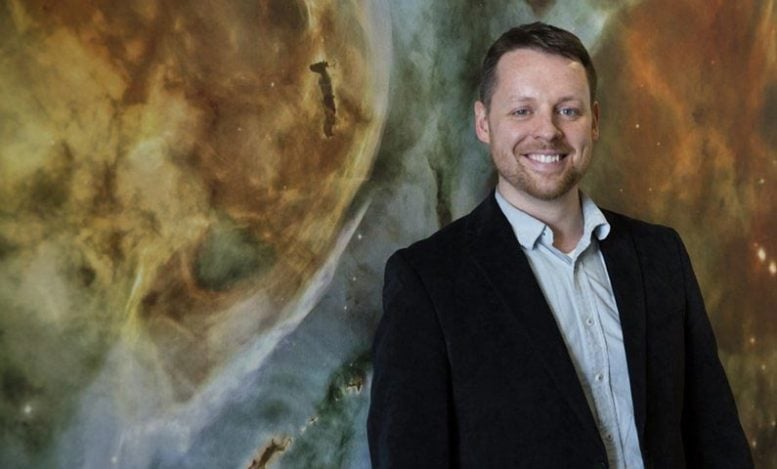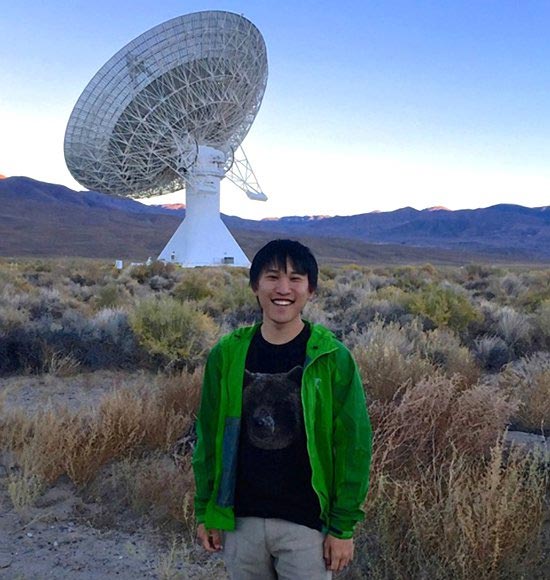This illustration shows a massive star that is about to explode. The explosion was triggered after its dead-star companion (a black hole or neutron star) plunged into the star’s core. Scientists say that the black hole or neutron star rammed into the massive star, and then, as it traveled inward over the course of centuries, ejected a spiral of material from the star’s atmosphere (pictured surrounding the star). When it reached the star’s core, material from the core rapidly fell onto the stellar corpse and this led to the launching of a pair of jets at nearly the speed of light. In this artist’s depiction, the jets are shown tunneling through the star, and will soon set off the supernova explosion. After a few years, the supernova will crash through the bulk of the ejected spiral, which extends to about 10,000 times the size of the star. This will create the luminous transient radio source observed by the Very Large Array. Credit: Chuck Carter
The first observation of a brand-new kind of supernova had been predicted by theorists but never before confirmed.
In 2017, a particularly luminous and unusual source of radio waves was discovered in data taken by the Very Large Array (VLA) Sky Survey, a project that scans the night sky in radio wavelengths. Now, led by Caltech graduate student Dillon Dong (MS ’18), a team of astronomers has established that the bright radio flare was caused by a
Dillon Dong, with a 40-meter radio dish at Caltech’s Owens Valley Radio Observatory in the background.
As Dong sifted through the VLA’s massive dataset, he singled out an extremely luminous source of radio waves from the VLA survey called VT 1210+4956. This source is tied for the brightest radio transient ever associated with a supernova.
Dong determined that the bright radio energy was originally a star surrounded by a thick and dense shell of gas. This gas shell had been cast off the star a few hundred years before the present day. VT 1210+4956, the radio transient, occurred when the star finally exploded in a supernova and the material ejected from the explosion interacted with the gas shell. Yet, the gas shell itself, and the timescale on which it was cast off from the star, were unusual, so Dong suspected that there might be more to the story of this explosion.
Two Unusual Events
Following Dong’s discovery, Caltech graduate student Anna Ho (PhD ’20) suggested that this radio transient be compared with a different catalog of brief bright events in the X-ray spectrum. Some of these X-ray events were so short-lived that they were only present in the sky for a few seconds of Earth time. By examining this other catalog, Dong discovered a source of X-rays that originated from the same spot in the sky as VT 1210+4956. Through careful analysis, Dong established that the X-rays and the radio waves were likely coming from the same event.

Gregg Hallinan
“The X-ray transient was an unusual event—it signaled that a relativistic jet was launched at the time of the explosion,” says Dong. “And the luminous radio glow indicated that the material from that explosion later crashed into a massive torus of dense gas that had been ejected from the star centuries earlier. These two events have never been associated with each other, and on their own they’re very rare.”
A Mystery Solved
So, what happened? After careful modeling, the team determined the most likely explanation—an event that involved some of the same cosmic players that are known to generate (function(d, s, id){
var js, fjs = d.getElementsByTagName(s)[0];
if (d.getElementById(id)) return;
js = d.createElement(s); js.id = id;
js.src = "https://connect.facebook.net/en_US/sdk.js#xfbml=1&version=v2.6";
fjs.parentNode.insertBefore(js, fjs);
}(document, 'script', 'facebook-jssdk'));
Read original article here
